
You have a beautiful garden. Flower and shrub borders around the edge, pots full of begonias, geraniums and sweet pea in full bloom dotted around your patio or decked area. But the lawn! No matter how hard you try, the inclement weather, kids, and pets wreak havoc with the flat, bowling-green type surface you’re trying to achieve. Maybe it’s time to think outside the box. Modern artificial grass is light years away from the fake grass of yesteryear. If you intend to do it yourself, here are six essential tips to help you install, and maintain, that flat green surface you’ve always wanted.
Plan and Prepare:
Before starting, work out the area to be covered. Most suppliers sell artificial grass by the square metre. Tools required include turf-cutter or garden spade, stiff bristle yard brush, craft knife and spare blades, club hammer and protective gloves.
Materials include fake grass, weed control membrane, edging strips, joining tape, edging staple pins, length of 4”x2” timber, and enough sharp building sand to attain an overall depth of about 25mm.
Remove Turf:
Remove the old lawn in manageable turfs to a rough depth of 50mm. Level as best as you can by removing any roots, old flints and stones, and filling in any deeper potholes. Tap edging strips into the soil for the grass lengths to butt up against. Lay sand, tamp down and level to a depth of 25mm using your length of timber.
If your do it yourself levelling skills are not that hot, tap wood or plastic pegs into the ground allowing 25mm to protrude above the soil. Lay your timber across two pegs and check they are the correct height using a spirit level sitting on top of the timber. As you level out the sand remove the pegs.
Lay the Weed Membrane:
Cover the whole area with your weed membrane. Join the membrane with a good quality gaff tape and trim off excess membrane around the edges. Make sure all joints are properly sealed with the tape to ensure weeds cannot push their way through.
Time to Fit your Artificial Grass:
Before laying your grass make certain the ‘pile’, or grass blades, are all sloping in the same direction. For best aesthetic appeal, lay your grass with the blades pointing toward the house. Unless you have an absolute square or rectangular area to turf, start at the widest part, and keeping your edge in a straight line pointing toward the house allow the edge side to overhang as much as it needs to, but don’t trim until the whole area has been laid and joined. Butt each length of grass lightly against the other but stagger the breaks between the strips.
Taping the Joints:
Ensure you have bought a good quality joining tape. Fake grass tape is available in a sticky tape form, or as a tape which requires an adhesive added. Have a word with your supplier as to what would be the best for your particular needs.
Fold back both strips that have to be joined and lay the tape through the centre. Add adhesive if required then lay one length of grass back onto the tape followed by the other. Don’t try to do a long run all in one go, do shorter areas and then apply pressure to ensure maximum adhesion. Lay your length of 4”x2” along the new join to provide extra weight while the adhesive is curing.
Finishing Off:
With the joints on your new lawn fully sealed, begin trimming the edges. Make sure the craft knife blade is sharp, and replace it around every four or five metres of trimming, then add anchoring pins where required around the edges.
Once everything is fixed, secure, and cured, give the whole area a good stiff brushing with your yard broom, paying particular attention to covering the joins.
Though not a necessity, for a little more realistic appeal liberally sprinkle a few kg of kiln-dried sand over the grass and then give the whole area another good brush over. Finally, stand back and admire.
For more information about Artificial Grass, click here.
